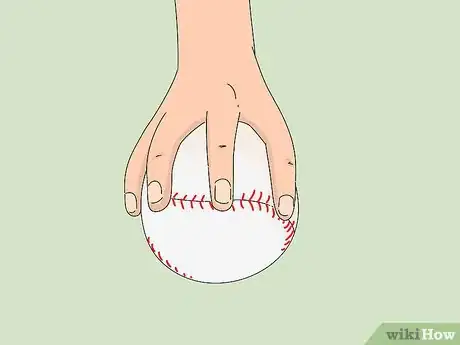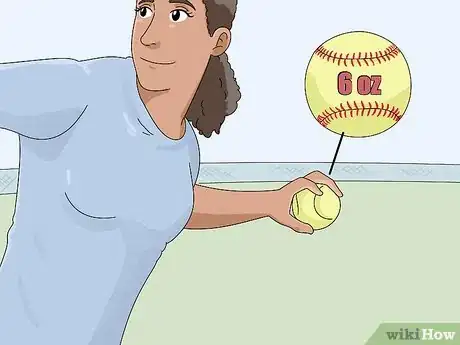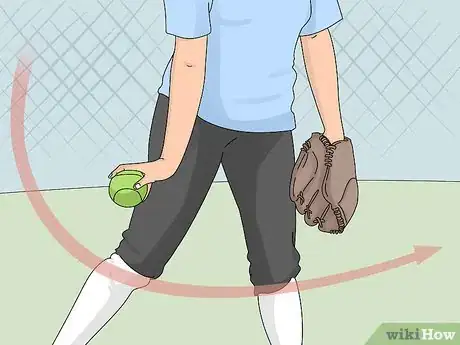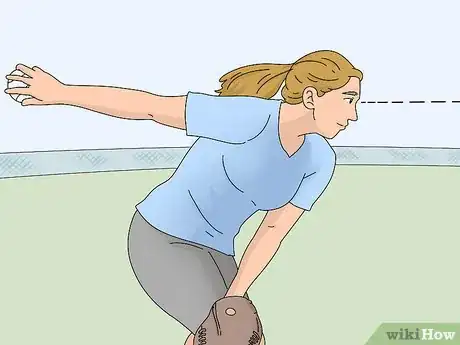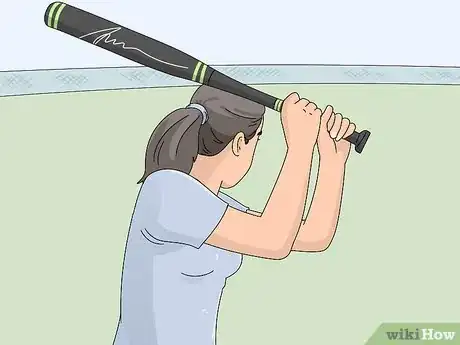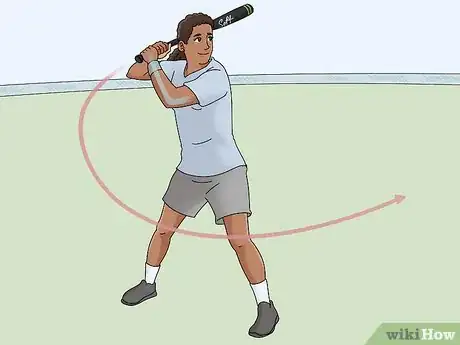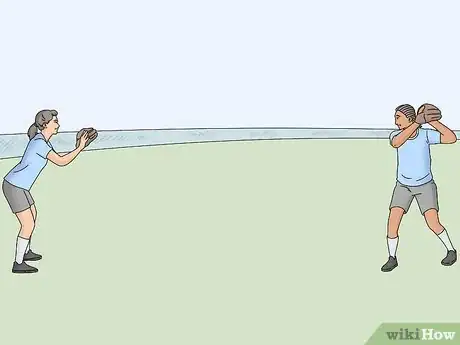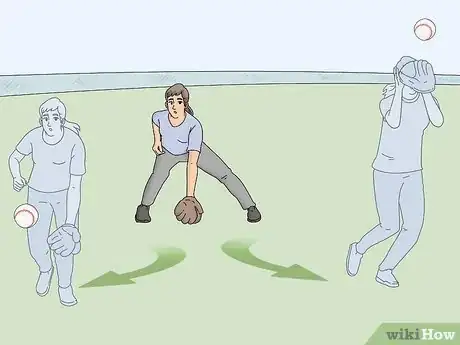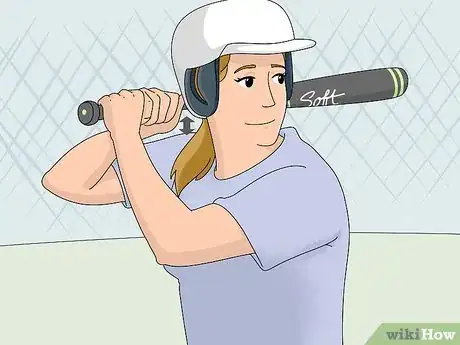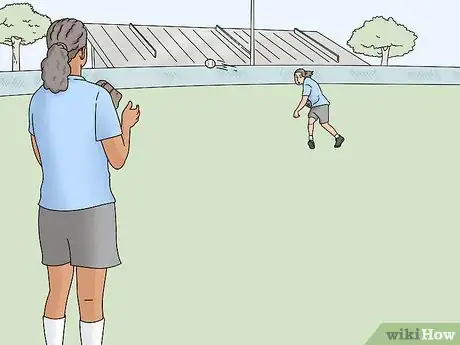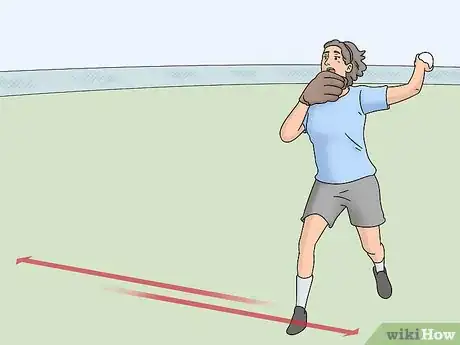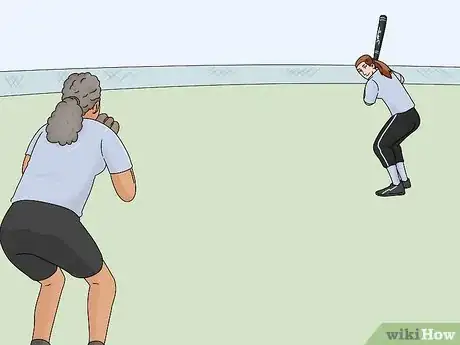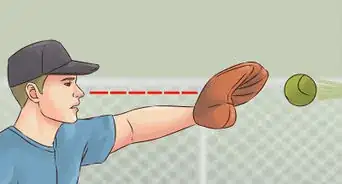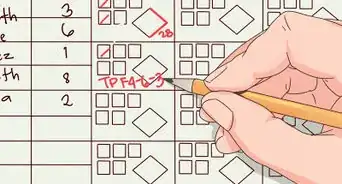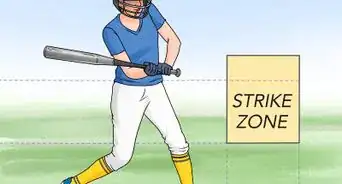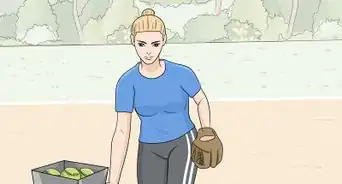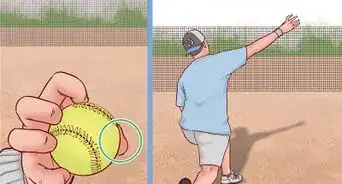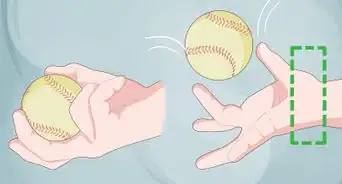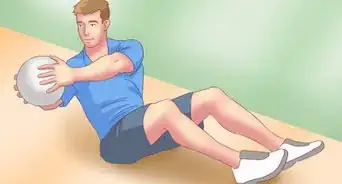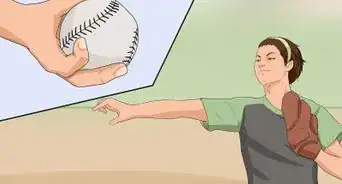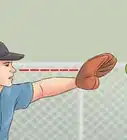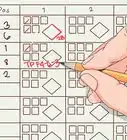This article was co-authored by Haley Snyder and by wikiHow staff writer, Janice Tieperman. Haley Snyder is a former Division I Student-Athlete and Softball Player. With over a decade of experience, she specializes in softball mechanics, fundamentals, and pitching. Haley holds a BA and MA from Stanford University, where she competed in the PAC-12 Conference as a pitcher.
There are 12 references cited in this article, which can be found at the bottom of the page.
wikiHow marks an article as reader-approved once it receives enough positive feedback. In this case, several readers have written to tell us that this article was helpful to them, earning it our reader-approved status.
This article has been viewed 132,324 times.
Softball is a fun and thrilling sport that requires a lot of hard work and focus. If you feel like you aren’t living up to your full potential as a softball player, consider re-evaluating your techniques as you bat, throw, and catch. Additionally, take a moment to think about the demands of your current position, and how you can adjust your practice schedule to hone your skills on the field. With enough focus and dedication, you’ll start to see your softball skills improve!
Steps
Improving Your Throw
-
1Keep your elbow higher so you can throw farther. Pitch the ball with your arm positioned above your shoulder. While the throwing motion will eventually bring your arm to waist or hip level, try to keep your elbow at a higher starting level. When you create the round throwing motion with your arm and elbow, a higher starting point will create more momentum for the ball.[1]
- Make sure that you’re using a fielding glove when you practice, and not a fielding mitt.
-
2Thrust your palm forward before letting go with your fingers. Aim to hold the ball in a four-seam grip, where your pointer, middle, and ring finger are positioned behind the edge of the seam you’re choosing to hold. When you’re holding the ball, don’t rest it against your palm. Instead, use palm as a source of momentum as you start to throw, then lift up your fingers quickly to release the ball.[2]
- One of the most important elements of this type of throw is timing. Practice releasing your fingers at the exact moment your palm hits so that the throw can get more speed.
Advertisement -
3Practice throwing balls heavier than 6 ounces (0.17 kg) to improve your strength. Build muscle in your arms by practicing with softballs that are heavier than what you plan on using in an actual game. Keep your throwing technique consistent, even if your arm feels a bit more tired. When you play with a normal-sized ball, your arm will feel much more adjusted to the throw.[3]
Tip: If you want to focus more on your throwing technique, try practicing with softballs that are lighter than the standard size.
-
4Move your arm in a fluid motion to give the pitch momentum. Continue throwing the ball with your usual technique, using a circular motion as your arm swings over your shoulder to waist or hip level. As you swing downwards, don’t slow your movement—instead, keep your arm moving swiftly when you release the ball. If you do this, you’re more likely to release a more powerful pitch.[4]
- If you slow down your arm at the end of the throw, you can lose pitch speed.
-
5Eye your target before you release the ball. Whether you’re pitching or fielding, make firm eye contact with where you want to throw the ball. Don’t let your gaze waver—even if your aim is not always consistent, you’re much more likely to have success if you throw with a target in mind. As you throw, keep your shoulders and hips angled in the direction of this target.[5]
- Be sure to square your shoulders in a specific direction whenever you throw the ball. Your shoulders help serve as an invisible guide to which direction the ball goes.
Fixing Your Swing
-
1Keep your elbows down so your arms don’t tire out. Don’t splay out your arms while you’re at the batting mound. Try to keep your elbows lowered whenever you swing the bat. If you’re having difficulty finding the right posture, try taking a few practice swings while a coach, friend, or family member watches. Ask the person to tell you if and when your elbows fly upwards so you can have a rough idea of your own batting habits.[6]
- When you keep your elbows up, you give your body more gravity to fight against while swinging. Keep your elbows down to increase your chances for successful hits!
- Repetition helps you improve as a hitter. The more repetitions you get, the less you're going to have to think about on game day. You want batting to become muscle memory since softball is such a quick sport.[7]
- Along with throwing, bat as often as you can.[8]
-
2Grip the bat in the same way that you’d shake someone’s hand. Pick up the bat, envisioning that you’re greeting someone with a handshake. You wouldn’t have a floppy grip when shaking someone’s hand, so don’t have that kind of grip on the bat, either. Once your dominant hand is in place, secure your opposite hand above or below on the bat’s handle.[9]
- While you want your grip to be secure, make sure that your hands are loose, as well. When you hit the ball, you want to be able to let go of the bat quickly and easily!
- Keep in mind that your hands will be in different positions depending on how you swing. If you’re left-handed, then your right hand will be below your left hand. If you’re right-handed, then your left hand will be below your right hand.
Tip: Your knuckles should always be in a straight line along the handle when you bat.[10]
-
3Use your lower hand to control the swing. Direct the bat with the lowest hand, otherwise known as your guiding hand. Make sure that you start the swing with your shoulders and not just your forearms. Use your lower hand to keep the bat centered in a specific direction. Once the bat makes contact with the softball, complete the swing by bringing the bat past your opposite shoulder.[11]
- Try to keep your head in line with your belly button as you bat.
-
4Stay focused on the ball at all times. Don’t let yourself get distracted by the other fielders or any other aspect of the game. Use your best judgement as the ball arrives, using your shoulder to time and follow through with the swing. Keep staring at the ball, even when the pitcher is holding it.[12]
- Even when you’re focused on the ball, don’t lose sight of your batting stance! Remember to keep your knees, hips, and shoulders angled in the same direction.
Mastering the Catch
-
1Practice catching a tennis ball to improve your technique. Build catching confidence by having another player throw smaller balls in your direction. As they throw, make sure that the other player aims the ball for the center of your chest so you can practice securing the ball in the palm of your glove. Once you’ve mastered this skill, have the softball be aimed at your shoulders, where you can try the same technique.[13]
- While this method is generally used with younger players, it can be a good way to refresh your catching technique. If you feel comfortable, try this drill with a normal softball.
Did you know? There are 2 types of baseball gloves: a fielding glove and a fielding mitt. The fielding mitt has extra padding and is only used by first base players and catchers.[14]
-
2Shift your body to the direction of the airborne ball. Support the catch with your whole body and not just your arm. You don’t want to extend your hand to catch the ball; instead, try centering yourself to be directly in the ball’s path. As you catch the ball, try to secure it in the palm of your glove instead of in the fingertip area.[15]
- You can position your glove differently depending on the angle of the ball. If you’re catching a low throw, then keep the fingers of your glove pointing downwards. If you’re securing a higher throw, then keep your glove in an upright position.
- Don’t try to snag the ball by the tip of your glove—this raises the risk of the ball dropping altogether.
-
3Bring your glove to your throwing shoulder so you’re ready to pass the ball. Practice catching and throwing the ball in smooth, fluid motions. After you catch a stray ball, lead your glove to the throwing shoulder so your dominant hand can grab and throw the softball more easily. To better get the hang of this, try practicing with a group of friends.[16]
- Remember to squeeze your glove whenever you catch the ball. If you don’t do this, there’s a chance that the ball could slip out.
Reviewing Fielding Skills
-
1Hone your overhand throw if you’re an outfielder. Keep your fingers splayed along the back half of the softball as you prepare to throw. Since the overhand throw is the most powerful, remember to always use this technique when you’re playing an outfield position. Pivot and step as you release the ball, as this provides both momentum and direction to your throw.[17]
- When you’re throwing overhand, pretend like you’re about to high-five someone.
-
2Try catching balls in fast succession if you’re an infielder. If you’re playing softball with friends, practice throwing balls to one another very quickly, like a game of hot potato. In an intense softball game, you’ll have to catch a lot of balls with speed and skill. Focus on accuracy and speed as you hone your reflexes.[18]
- In many cases, good reflexes can separate a good infielder from a great infielder. As you practice, work on boosting your reflexes to improve your game play.
-
3Throw balls in different directions to improve your skill as an infielder. Memorize the demands of your usual position and try to anticipate the different plays that you’ll have to make. In a fast-paced game, you might have to make quick throws in multiple directions to secure bases. When you practice, envision where the ball might be coming from and prepare yourself accordingly.[19]
- For example, a shortstop player should practice throwing the ball in the direction of second base or third base. A third base player, on the other hand, should focus on throwing the ball to the catcher, second base player, and first base player.
- To improve multi-directional throwing, try practicing with 2 other people. Stand about 30 feet (9.1 m) apart from one another in a triangle formation and practice jumping and pivoting to throw the ball in a new direction.[20]
-
4Angle yourself so that you’re facing the batter. Stay prepared whenever you’re in the field. You‘ll have more difficulty focusing on a ball that isn’t centered in your line of sight. Whether you’re practicing with a team or with a handful of friends, try to get in the habit of adjusting and squaring your shoulders, hips, and knees to face the batter.[21]
- This is especially important to keep in mind as an infielder.
-
5Practice different squats to be ready for various situations. Remember to imitate a frog as you get ready to catch the ball, with your mitt centered above and between your knees. As you maintain this position, try not to extend your arm to catch any strikes or balls. When the pitches are thrown lower, keep your knees planted on the ground with your glove resting between them.[22]
- Try transitioning between these 2 stances in preparation for a variety of different pitches and plays.
Expert Q&A
-
QuestionWhat is a good exercise for softball players?
 Haley SnyderHaley Snyder is a former Division I Student-Athlete and Softball Player. With over a decade of experience, she specializes in softball mechanics, fundamentals, and pitching. Haley holds a BA and MA from Stanford University, where she competed in the PAC-12 Conference as a pitcher.
Haley SnyderHaley Snyder is a former Division I Student-Athlete and Softball Player. With over a decade of experience, she specializes in softball mechanics, fundamentals, and pitching. Haley holds a BA and MA from Stanford University, where she competed in the PAC-12 Conference as a pitcher.
Softball Player Practice playing softball when you're already worn out. For instance, you might lift some weights or do conditioning reps before practicing your swings and throws.
Practice playing softball when you're already worn out. For instance, you might lift some weights or do conditioning reps before practicing your swings and throws. -
QuestionHow can I be a good infielder in softball?
 Haley SnyderHaley Snyder is a former Division I Student-Athlete and Softball Player. With over a decade of experience, she specializes in softball mechanics, fundamentals, and pitching. Haley holds a BA and MA from Stanford University, where she competed in the PAC-12 Conference as a pitcher.
Haley SnyderHaley Snyder is a former Division I Student-Athlete and Softball Player. With over a decade of experience, she specializes in softball mechanics, fundamentals, and pitching. Haley holds a BA and MA from Stanford University, where she competed in the PAC-12 Conference as a pitcher.
Softball Player Practice a variety of situations, like catching and throwing ground balls. For instance, sending a ground ball to your left and restoring it to your right demand different types of footwork.
Practice a variety of situations, like catching and throwing ground balls. For instance, sending a ground ball to your left and restoring it to your right demand different types of footwork. -
QuestionHow can I hit better in softball?
 Haley SnyderHaley Snyder is a former Division I Student-Athlete and Softball Player. With over a decade of experience, she specializes in softball mechanics, fundamentals, and pitching. Haley holds a BA and MA from Stanford University, where she competed in the PAC-12 Conference as a pitcher.
Haley SnyderHaley Snyder is a former Division I Student-Athlete and Softball Player. With over a decade of experience, she specializes in softball mechanics, fundamentals, and pitching. Haley holds a BA and MA from Stanford University, where she competed in the PAC-12 Conference as a pitcher.
Softball Player Get plenty of practice time in. The more repetitions you do, the less you'll have to think about when game day arrives. Ultimately, you want your hitting skills to be rooted in muscle memory.
Get plenty of practice time in. The more repetitions you do, the less you'll have to think about when game day arrives. Ultimately, you want your hitting skills to be rooted in muscle memory.
Warnings
- Don’t overwork yourself. Listen to your body—if your muscles feel especially strained and sore, scale back on your practice or take a day to rest altogether.⧼thumbs_response⧽
References
- ↑ http://websites.sportstg.com/get_file.cgi?id=3788241
- ↑ https://www.softball-spot.com/softball-fielding-techniques-outfield/2046/
- ↑ https://www.sportsrec.com/438151-how-to-throw-a-softball-harder-faster.html
- ↑ https://m.youtube.com/watch?v=we1dNGT1HZQ&feature=youtu.be&t=3m24s
- ↑ https://www.softball-spot.com/5-keys-to-softball-throwing/2680/
- ↑ https://www.softball-spot.com/softball-hitting-developing-bat-speed/2241/
- ↑ Haley Snyder. Softball Player. Expert Interview. 23 June 2021.
- ↑ Haley Snyder. Softball Player. Expert Interview. 23 June 2021.
- ↑ https://www.softball-spot.com/softball-hitting-developing-bat-speed/2241/
- ↑ http://websites.sportstg.com/get_file.cgi?id=3788241
- ↑ http://websites.sportstg.com/get_file.cgi?id=3788241#
- ↑ http://websites.sportstg.com/get_file.cgi?id=3788241
- ↑ https://www.softball-spot.com/how-to-improve-youth-catching-skills-0612/1597/
- ↑ http://websites.sportstg.com/get_file.cgi?id=3788241
- ↑ http://websites.sportstg.com/get_file.cgi?id=3788241
- ↑ http://websites.sportstg.com/get_file.cgi?id=3788241
- ↑ http://websites.sportstg.com/get_file.cgi?id=3788241
- ↑ http://websites.sportstg.com/get_file.cgi?id=3788241
- ↑ http://websites.sportstg.com/get_file.cgi?id=3788241
- ↑ https://www.softball-spot.com/jump-pivot-triangle-fielding-drill/4673/
- ↑ http://websites.sportstg.com/get_file.cgi?id=3788241
- ↑ http://assets.softball.org.au/dl/sal/Coaching/Resources/FUNdamentals/FUNdamental%20Skills.pdf
- ↑ Haley Snyder. Softball Player. Expert Interview. 23 June 2021.
- ↑ Haley Snyder. Softball Player. Expert Interview. 23 June 2021.
- ↑ Haley Snyder. Softball Player. Expert Interview. 23 June 2021.
- ↑ https://kidshealth.org/en/teens/power-positive.html
About This Article
Being a better softball player is all about mastering your pitching, batting, and fielding skills. As a pitcher, practice throwing the ball faster and more accurately. Try throwing heavier balls to build your arm strength. To improve your batting, work on hitting the ball accurately and keeping your elbows down to preserve your energy. Use your lower hand to direct the swing and use your shoulders as well as your forearms to gain power. You should also work on catching and throwing the ball in quick succession to train you for fielding. As soon as you catch the ball, transfer it to your throwing hand to save you valuable time. Throw the ball to different distances and in different directions so you’ll be ready for any play. For more tips, including how to perfect your overhand throw, read on!

